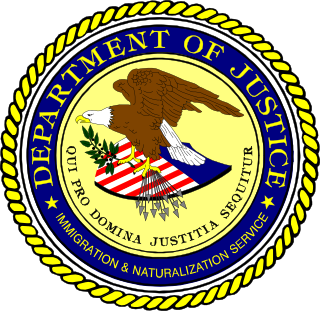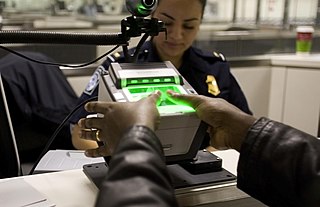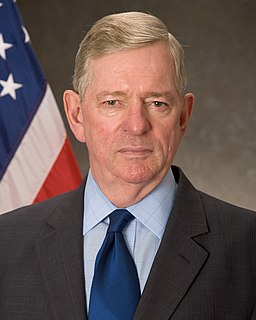
The United States Department of Homeland Security (DHS) is the U.S. federal executive department responsible for public security, roughly comparable to the interior or home ministries of other countries. Its stated missions involve anti-terrorism, border security, immigration and customs, cyber security, and disaster prevention and management.

The United States Immigration and Naturalization Service (INS) was an agency of the U.S. Department of Labor from 1933 to 1940 and the U.S. Department of Justice from 1940 to 2003.

United States Visitor and Immigrant Status Indicator Technology is a U.S. Customs and Border Protection (CBP) management system. The system involves the collection and analysis of biometric data, which are checked against a database to track individuals deemed by the United States to be terrorists, criminals, and illegal immigrants. US-VISIT is accessed by 30,000 users from federal, state, and local government agencies. Upon Presidential approval of the 2013 Continuing resolution the US-VISIT program officially became the "Office of Biometric Identity Management" (OBIM), save for portions of the agency which performed overstay analysis being transferred into U.S. Immigration and Customs Enforcement and biometric Entry and Exit operations which became a part of U.S. Customs and Border Protection.

The United States Border Patrol (USBP) was created on May 28, 1924. As of 2021, it was a federal office within Customs and Border Protection (CBP), which was, in turn, an agency of the Department of Homeland Security (DHS). It is the largest federal law enforcement agency.

The United States Customs Service was an agency of the U.S. federal government that collected import tariffs and performed other selected border security duties.

United States Customs and Border Protection (CBP) is the largest federal law enforcement agency of the United States Department of Homeland Security, and is the country's primary border control organization. It is charged with regulating and facilitating international trade, collecting import duties, and enforcing U.S. regulations, including trade, customs, and immigration. CBP is one of the largest law enforcement agencies in the United States. It has a workforce of more than 45,600 sworn federal agents and officers. It is headquartered in Washington, D.C.

United States border preclearance facilities are prescreening border controls operated by the United States Department of Homeland Security at airports and other ports of departure located outside the United States under agreement between the host country and the federal government of the United States. Travelers are subject to immigration and customs inspections by U.S. Customs and Border Protection (CBP) officers before boarding their transportation onward to the United States. Preclearance applies to all passengers regardless of their nationality or purpose of travel. Upon arrival, precleared passengers are treated as domestic passengers and do not need to be screened again. This process is intended to streamline border procedures, reduce congestion at American ports of entry, and facilitate travel into airports that otherwise lack customs processing facilities. Its practice is questioned by civil liberty rights groups.

A border guard of a country is a national security agency that performs border security. Some of the national border guard agencies also perform coast guard and rescue service duties.

Jayson P. Ahern is the former Acting Commissioner of U.S. Customs and Border Protection. He was Assistant Commissioner for Field Operations from March 2003 to August 2007. He managed an operating budget of $2.2 billion and directs the activities of more than 25,000 employees, including more than 19,000 CBP Officers and Agriculture Specialists, and oversees the programs and operations at 20 Field Operations offices, 317 ports of entry and 14 preclearance stations in Canada and the Caribbean. He was responsible for Immigration Policy and Programs that includes all immigration issues related to the admission and exclusion of aliens as well as the Agricultural Inspection at all Ports of Entry to protect the health of U.S. plant and animal resources and the facilitation of their movement in the global market place.

Air and Marine Operations (AMO) is a federal law enforcement agency within U.S. Customs and Border Protection (CBP), a component of the United States Department of Homeland Security (DHS). AMO's mission is to protect the American people and nation's critical infrastructure through the coordinated use of air and marine assets to detect, interdict and prevent acts of terrorism and the unlawful movement of people, illegal drugs, and other contraband toward or across the borders of the United States. Air and Marine Operations Agents and Officers are endowed with the authority to enforce Title 8 and Title 19 (Customs) of the United States Code in addition to the general law enforcement powers bestowed upon federal law enforcement agents.

William Ralph Basham, Jr. has served at the head of four of the eight U.S. Department of Homeland Security agencies, including as Commissioner of U.S. Customs and Border Protection, the largest federal security force in the United States government, Director of the United States Secret Service, Director of the Federal Law Enforcement Training Center and as one of the first employees as Chief of Staff at the Transportation Security Administration.
U.S. Citizenship and Immigration Services (USCIS) is an agency of the United States Department of Homeland Security (DHS) that administers the country's naturalization and immigration system. It is a successor to the Immigration and Naturalization Service (INS), which was dissolved by the Homeland Security Act of 2002 and replaced by three components within the DHS: USCIS, Immigration and Customs Enforcement (ICE), and Customs and Border Protection (CBP).

The Border Patrol Tactical Unit (BORTAC) is the tactical unit of the United States Border Patrol. In 2007, BORTAC was placed under the command of the newly formed Special Operations Group (SOG) together with the Border Patrol Search, Trauma, and Rescue Unit (BORSTAR).

The Office of Field Operations (OFO) is a federal law enforcement agency within the U.S. Customs and Border Protection (CBP) responsible for managing United States customs operations at 20 Field Operations offices, 328 ports of entry, and 16 pre-clearance stations in Canada, Ireland, the UAE, and the Caribbean. Headed by a CBP Assistant Commissioner, OFO directs the activities of more than 27,000 employees, including more than 22,000 CBP Officers and Agriculture Specialists. CBP Office of Field Operations is the largest component in CBP. It is headed by Assistant Commissioner Todd Owen.
SBInet, the Secure Border Initiative Network, was a program initiated in 2006 for a new integrated system of personnel, infrastructure, technology, and rapid response to secure the northern and southern land borders of the United States. It was a part of Secure Border Initiative (SBI), an overarching program of the United States Department of Homeland Security (DHS) to organize the four operating components of border security: U.S. Customs and Border Protection (CBP), U.S. Immigration and Customs Enforcement, United States Citizenship and Immigration Services, and the United States Coast Guard. DHS announced the program's cancellation on Jan. 14, 2011.
Project 28 is the name given to a U.S. border protection program that runs along a 28-mile (45 km) stretch of the US/Mexican border in southern Arizona. The project, the first phase of a much larger program called the "Secure Border Initiative network" (SBInet), was scheduled to be completed in mid-2007, but did not become operational until late 2007. It involves the placement of 9 high-tech surveillance towers that monitor activity using radar, high-resolution cameras, and wireless networking, looking for incursions to report to the Border Patrol.
The Office of Immigration Statistics (OIS) is an agency of the United States Department of Homeland Security under the Office of Strategy, Policy, and Plans.

Command Group, "CG", founded as Command Consulting Group, is an international security and intelligence consulting firm, founded in 2009, headquartered in Washington, D.C., United States. CG provides advisory services for governments, corporations, and high net worth individuals.

Mark A. Morgan is an American law enforcement official who served as the Chief Operating Officer and acting Commissioner of U.S. Customs and Border Protection from July 5, 2019, to January 20, 2021.
Enforcement with consequences is the policy implemented within the US to help deter the rising tide of immigration that has grown in the US. It is the expansion of policy and consequences for people who choose to enter illegally and subjects them to legal, political and educational debates concerning legality status.














